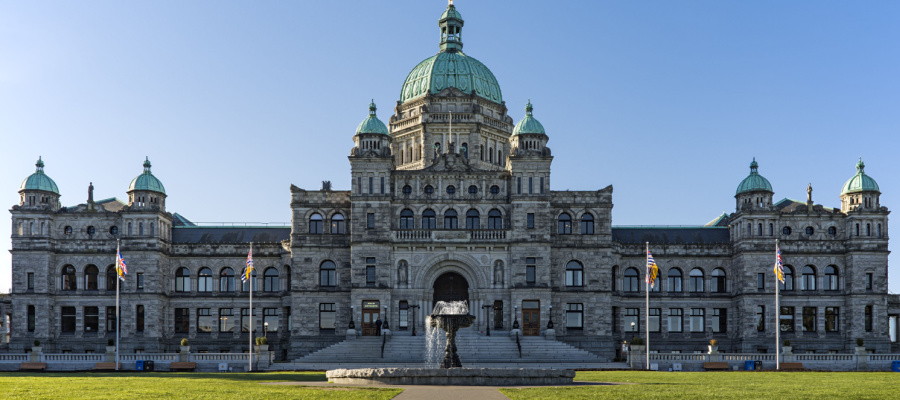Take Two: BC Budget 2009 September Update (Notes from Marc and Iglika)
The September BC Budget is a new look at a budget most have come to see as a fake. February’s budget was not passed through the legislature due to the May election, and up to E-Day the government maintained the fiction that it had a small-ish deficit of just under half a billion dollars. Since that time, the government moved out of denial about the recession and revealed that it could not in fact meet its deficit target, and made loud noises about expenditure cuts through the summer.
We have argued that broad-based spending cuts are unnecessary since BC does not have an expenditure problem, just a short-term revenue problem arising from the recession. Running a large deficit is entirely appropriate and good economics. The last thing BC needs is a government piling on with spending cuts on top of the downturn — this will only worsen the economic picture and throw more people out of work.
To some small extent this message seems to have gotten through – the government will allow the 2009/10 deficit to reach $2.8 billion this year. However, the new budget announced $1.5 billion in “administrative savings” over three years and it’s not clear yet exactly where these will come from (more on this below). The choices tell us that on balance the government’s actions will exacerbate the recession, particularly in smaller communities around the province.
The new economic projections paint a more sober picture of the BC economy in 2009: a 2.9% drop in real GDP; 5% drop in nominal GDP; 2.8% decline in total employment. The average unemployment rate is now forecast at 7.9% for 2009, rising to 8.3% in 2010, and slowly declining to 7.0% in 2013. So the expectation is for “jobless growth” for a few more years. Overall improvements by 2011 are predicated on US and Canadian recoveries.
Based on this gloomy short-term outlook, the new BC Budget figures a deficit of $2.5 billion, or 1.3% of provincial GDP — $2.8 billion or 1.5% of GDP if we add the forecast allowance. Although much ado has been made of the size of the deficit in dollars, as a percent of GDP this is not particularly large by historical standards or even compared to what other provinces are doing. The overall number is consistent with Iglika’s estimate of a status quo deficit on the order of $3.2 to $3.9 billion, because the BC budget banks $750 million from the feds for HST transition (the full $1.6 billion in total transitional funding is spread over three years).
The good news is that most public services have more or less been preserved and there are even some modest increases in some budgets compared to February’s first take. In fact, total expenditures are up $826 million compared to February, although a big chunk of this is increased expenditures for fire fighting (file this one under climate change adaptation).
Some other budget lines had to increase due to the recession – an additional $100 million (compared to Feb) for social assistance, the expenditure area most sensitive to the economy. Compared to 2008/09 this is an increase of 8.8%, and seems too small given that the total caseload is expected to rise by almost 17% (the temporary assistance caseload is up more than that, about 33% higher than 2008/09). Child welfare is also up substantially, by $115 million higher than February. But on the cutting room floor, the budget for community living and related services was pared back by $154 million relative to Feb (though this is still a small net increase in dollars relative to last year’s budget).
Health care sees an overall budget increase of $189 million compared to Feb (and $790 million or 5.2% above 2008/09 levels). In spite of this, there will continue to be challenges in certain areas of the province and certain services. Health authorities identified a $360 million shortfall over the summer and that has led to cuts in services like outreach to seniors.
For K-12 education the picture is much worse, with a cut of $31 million from February — a measly $3 million increase over 2008/09 (on a budget of $5.7 billion). This is going to hurt and already school districts and schools across BC are implementing cuts to staff and increases in class size. For post-secondary education there is an increase of $160 million from February and $177 million, or 3.9%, over 2008/09 – not great (especially with the prospect of rising enrollment due to the recession) but increases nonetheless.
What is going to sting are a litany of smaller cuts spread across all of the government’s operations, in particular reduced or eliminated grants to NGO service providers and charities, arts and culture groups, and students. All told these cuts are tiny compared to the overall provincial budget, but devastating to the programs themselves. They could easily have been accommodated in only a slightly higher deficit. No detail in terms of specific cuts is provided in the budget itself but overall grants are cut by $354 million, a reduction of 30% from 2008/09. Cuts to grants account for more than half of the identified “savings” from Administrative and Discretionary Spending (Table 1.14). Further “efficiencies” (ie, more cuts) on the order of half a billion dollars will need to be found in 2010/11 and 2011/12, and these are all on top of $1.9 billion in “savings” over three years announced in February’s budget.
The government’s news release speaks a lot about infrastructure spending and stimulus but in fact the budget contains nothing new. Budgeted capital spending is up, although this reflects the addition of funds for the new Port Mann bridge, which were not available back in February. This is a dumb capital expenditure that attempts to build our way out of traffic congestion even though such approaches have never been successful anywhere in the past. In fact, funds for some other capital projects have been scaled back, offsetting somewhat the increase due to the PM.
On the revenue side, total revenues are projected to fall by $1.45 billion in 2009/10 from 2008/09, although this is offset by that $750 million in HST funding from the feds. Revenues are down across the board with the biggest hits on personal income tax revenues (almost $900 million) and natural gas royalties (almost $500 million). The latter is down to $522 million in 2009/10 from $1.3 billion in 2008/09.
A surprise is that Medical Service Plan (MSP) premiums are going up by 6%. This is BC’s most regressive source of revenue (BC is the only province that retains these premiums), one that actually has no linkage to health care spending. This represents about $36 per individual per year, and $72 per family, and there is an enhancement of the premium assistance that will see low-income individuals (under $30,000 income) and families (under $40,000 income) pay less. While these are not huge amounts, this is not what most families with $40,000 of income and up would want after already getting dinged by the HST.
The MSP increase contrasts with an across-the-board income tax reduction in the form of a higher basic personal exemption (to $11,000; this is the threshold at which on begins to pay income tax). Yes, another tax cut I do not need and did not ask for. The cost of the higher exemption is $173 million when fully implemented, compared to a net increase of $107 million from higher MSP. All individuals making more than $11,000 benefit by $72. It hardly makes sense to spread such a thin tax cut across the province when there are pressing needs arising due to the recession.
So why go ahead with this tax cut and MSP increase at the same time? Why table a large deficit but introduce widespread cuts that are going to adversely affect communities across the province? Such is the bizarre world of BC Budget 2009 Take Two.
Topics: Economy, Health care, Poverty, inequality & welfare, Provincial budget & finance, Taxes


